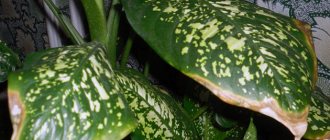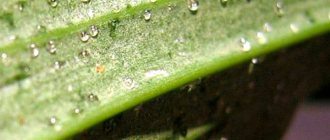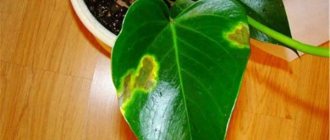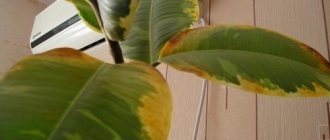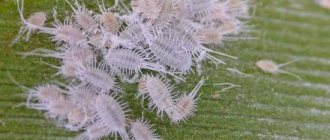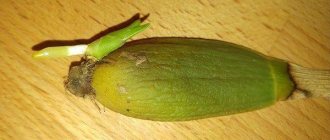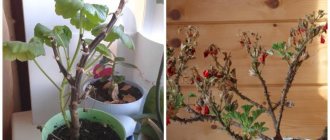In today's episode:
Hello Begonia elatior lovers!
If you are familiar with the situation when begonia elatior leaves deteriorate: they turn pale, acquire a strange glossy shine, then dry out completely, and the plant itself dies, then this article is for you.
Today we will look at examples of why begonia elatior begins to wither, shine and die, and why no spraying will help in this case.
And I just have such a patient. And the situation is critical, the flower must be saved.
I believe that there are 2 reasons for such a poor appearance of the plant; they are closely interrelated. Let's look at them.
Why do begonia leaves turn black?
If the tips of the leaves dry out and turn black, this indicates insufficient watering. Begonia is a tropical plant and loves moisture. This plant needs to be watered so that the ground is slightly moist: in summer - 2 times a week, in winter - no more than once. In the hottest weather, begonia needs to be watered every day.
Interesting materials:
How to remove old sealant from plastic windows? How to remove old sealant in a shower stall? How to remove old sealant in the bathroom? How to remove old sealant? How to remove old adhesive from tiles? How to remove old adhesive from tiles? How to remove old glue from the floor? How to remove old glue from walls? How to remove an old printer from a computer? How to delete an old pass?
Features of growth
Begonia is very light-loving, and the optimal temperature for plant growth is 15-24 degrees Celsius. The plant should be protected from direct sunlight, as the leaves are very sensitive and burns easily appear on them. The plant will feel best on the southwest or southeast side.
Watering
The flower must be watered in a timely manner. During the spring-summer period, this procedure is carried out daily; in winter, the regularity of watering should be reduced. If there is a lack of moisture, the growth and development of the plant may stop completely.
It is important to follow simple watering rules :
- The water should sit for several days.
- The temperature of the liquid should be the same as the room temperature.
Important ! When watering, be sure to ensure that the water does not stagnate.
Top dressing
The flowering process is usually very abundant. Accordingly, during this period the plant definitely requires feeding. Mineral concentrates are well suited for fertilizer. Now in specialized stores you can also find fertilizers designed specifically for begonias - they are also perfect for supporting the plant during the growing season.
Causes of the problem
By its external condition, you can almost always determine what is wrong with the plant , what it lacks, and accordingly, based on this, you can make the right decision about what kind of help the flower needs to be given.
Insufficient watering
This sign indicates that the plant is not receiving the amount of moisture it needs. This applies both to watering itself and to air humidity.
Helping a plant in such a situation is quite simple.:
- It is necessary to establish the correct watering regime. The plant needs to be watered when the top layer of soil dries slightly.
- In winter, the plant must be regularly sprayed with a spray bottle (tips on caring for flowers in winter can be found here). But you need to take into account that it is better to spray water on a plant with fuzzy leaves next to the pot.
- A container of water that should be placed nearby will help cope with dry air.
Little light
Yellowing leaves indicate that the plant does not have enough light . If the first signs of yellowness appear on the plant, then you should find a more illuminated place for it. It is important to remember that begonia does not tolerate direct sunlight.
Reference ! If yellow leaves appear, also pay attention to watering. In some cases, yellowness appears when there is insufficient or excess moisture.
Too much moisture
If the leaves of the plant have darkened and begin to rot, this means that the flower is watered too much. In this case, the frequency of watering should be reduced. Diseased leaves need to be removed.
Lack of microelements
Even under ideal conditions, begonias may show signs of wilting. Very often this is due to the fact that the plant does not receive all the necessary substances in sufficient quantities. This often happens during the flowering period. To solve the problem of wilting in this case, it is necessary to introduce complementary foods to the plant. This should be done at least three times a month.
Diseases and pests
The plant is extremely susceptible to the appearance of powdery mildew and signs of rot . In addition, the flower can be attacked by caterpillars, thrips and aphids.
The plant should be inspected so that appropriate measures can be taken at the first appearance of pests and diseases:
- When rot and powdery mildew appear : it is best to replant the flower in new soil, remove the affected leaves, and treat the plant with a fungicide.
- If pests appear : spray the plant with karbofos, fitoverm or intavir, after which it is better to place the flower under a damp bag for a day to enhance the effect of the drugs.
Read more about begonia diseases and pests here.
Dying of old leaves
Begonia's lowermost leaves dry out and die . This is a natural process; in this case, you can simply remove them along with the cuttings.
Leaves turn yellow and dry and curl at the edges
Reasons for indoor plants
- The plant finds itself in an environment that is unusual for it . For example, with the onset of spring, vents and windows are opened in apartments, and a draft appears in the apartment, which begonia really does not like. Or, knowing that begonia is a light-loving plant, they put it on the balcony, wanting to please it with sun and warmth. And they achieve the opposite result. A plant that has received stress begins to rebel, the leaves dry out and wither. Solution: Return the flower pot to its usual conditions - on a warm, illuminated windowsill.
- If the leaves dry out and turn yellow in winter, then the culprit is the begonia’s love for a humid environment. Usually grown indoors on window sills, under which steam heating radiators are located. The air in the apartment is dry. Solution: Place the flower pot in another place. If this is not possible, you can place a cup of water nearby. Regular spraying with water will also help.
We humidify the air by spraying , trying not to get it on the plant, especially the buds.
- Lack of microelements. Solution: Pamper with regular fertilizing using complex fertilizers. Or use potassium nitrate.
Reasons for garden plants
- Hot and dry weather, insufficient irrigation . What to do: adjust the water supply. But there is a small nuance here. The roots do not like constant dampness, so you need to make sure that the soil is moist, but well ventilated and not constantly wet.
Diseases
To prevent any disease, you need to follow several rules:
- Gray rot. Symptoms: Gray watery spots appear on the leaves. Flowers and stems gradually become slippery and slimy, leaves dry out and begin to fall off. The reason is excessive moisture.
Treatment: Spray with one percent Bordeaux mixture or copper-soap solution (a little tar soap, 20 g of copper per liter of water). Treat with benomyl. Powdery mildew - white coating Symptoms: spots with a white coating appear on the leaves. If you do not take action, they increase in size and gradually cover the entire leaf completely, gradually the leaves turn brown, curl and dry out.
Infections
Indoor begonia can be affected by infections. Most often they appear from bad weather conditions and poor care.
Among the diseases are the following:
- powdery mildew;
- bacterial spot;
- gray rot;
Powdery mildew
Signs of powdery mildew are first characterized by white powdery spots on the leaves, then the leaf blade becomes dark in color and dries out. Control measures: treatment with Topaz, Fundazol, Fundazim.
Bacterial spot
Bacterial spotting manifests itself as follows: the leaves become covered with glassy watery spots. The green parts of the begonia turn brown, turn black and fall off. This is the most difficult infection to fight. Most likely, the flower cannot be saved. For prevention, begonia is sprayed with a 0.5% suspension of copper oxychloride.
Gray rot
Warm and humid weather can contribute to the appearance of gray rot. The disease appears as gray watery spots on the tops of stems that break and rot. All parts of the plant are slippery and unpleasant to the touch. You can save begonia with Bordeaux mixture or a solution of copper sulfate with the addition of laundry soap for better adhesion. Dissolve 20 g of soap and 2 g of copper sulfate in one liter of water. For severe damage, use a fungicide.
Other diseases
Begonias have several specific diseases and reactions to the environment:
| Problem | Solution |
| Young leaves are too small and pale | Feeding with nitrogen fertilizer is required. |
| Begonia leaves curl | Leaves begin to curl when it is too hot and dry. You need to adjust the settings. |
| The plant standing in the kitchen has drooped | Poisoning by natural gas combustion products. You need to move the flower to a safe place. |
| Leaves fall in winter | Too cold. The temperature needs to be adjusted. |
| Bubble spots. The leaves turn black. | Bacterial wilt. It needs to be treated with an antibacterial drug. |
Diseases that cannot be cured
Begonias have a number of diseases that cannot be treated. If their symptoms are detected, the plant should be destroyed, the pots and window sills should be disinfected, and neighboring flowers should be quarantined.
Incurable diseases include:
- nematode infection. Discolored leaves, sagging appears on the roots;
- cucumber mosaic. Yellow spots and rings. Leaves are deformed.
Cucumber mosaic
Useful tips
Professional gardeners give the following useful recommendations for keeping begonias:
- For irrigation, take well-settled or filtered water at room temperature. It can be acidified to make it softer. In cold weather, watering is done with warm water and only when the soil is dry.
- It is advisable to periodically loosen the soil to a depth of about 1 cm to improve the supply of oxygen.
- The room should be regularly ventilated to provide fresh air, but without drafts for plants.
- Deciduous begonias should properly organize a dormant period in the fall.
- The pot with begonias should be placed on a well-lit side, but without direct sunlight, which can cause burns.
- Provide the required level of humidity. To do this, carry out small sprays using a spray bottle. It should be noted that the air near the begonia is sprayed so that moisture does not fall on the leaves - this can cause brown spots to appear. To maintain humidity when the room is dry, it is recommended to place a container of water near the flowerpot or place the pot in a tray with wet pebbles.
- Regularly fertilize the vegetating plant.
- When replanting, use loose nutrient soil with a pH of 5.5–6.5. You can buy ready-made soil for begonias, or you can make a soil mixture based on leaf soil, peat, sand and humus.
- Watering should be done in moderation so that the water does not stagnate in the pot, as this leads to the appearance of many fungal diseases. It is recommended to water at the same time in the morning. During the period of ovary and flowering, the plant should be watered more abundantly.
Organizing care for begonia in such a way that its leaves do not wither is easy, even for a beginner. You just need to spend a little time, and your plant will delight you with its blooming appearance.
Begonia pruning, pinching and basic methods of propagation
Whatever type of begonia you have, home care includes the formation of a growing specimen - this requires regular pruning, which is also carried out for rejuvenation and health. When the begonia has grown to 8 cm in height, it needs to be pruned for the first time - the tops of the side shoots that have reached 12 cm are cut off, and they branch, the flower is formed into a lush bush. Even if it was not cut on time, and it has stretched out, losing its decorative effect, you can try to restore its former beauty by pinching the top and side shoots.
Begonia propagation - in the photo
For different types of begonias, there are specifics for pruning - the Royal one does not need this procedure at all, and thick-trunked varieties are pruned infrequently, as the shoots grow. Bush begonias are shortened regularly and quite strongly by cutting above the outer bud. Some gardeners believe that it is necessary to often pinch out the ampelous begonia, others recommend not to be zealous, but simply place it higher so that the shoots hang down. Experts recommend pruning tuberous begonia for the winter so that the plant can rest.
After pruning, you need to reduce watering of the begonia until shoot growth activates, then you can resume feeding. But the propagation of begonias is organized in the following ways:
- Cuttings;
- Parts of a leaf;
- Seeds;
- By dividing the rhizome of a tuber or bush.
Not everyone knows how to take a shoot from a begonia - cut a ten-centimeter cutting, remove the leaves at the bottom, shorten the rest by half, then root the cuttings in a begonia substrate, adding sand to it, and cover with glass or film. For a month, maintaining high humidity in the greenhouse, wait for new leaves. Then the greenhouse is opened briefly every day, gradually increasing these periods - after three months the young plant will bloom.
Elatior and Mason begonias are propagated by leaves, since they do not have stems - several young plants can be developed from one leaf. Cut the leaf into triangles, each of which has veins, stick the pieces into wet sand or simply spread them over its surface, set up a greenhouse and proceed in the same way as when cutting.
Begonia Elatior - pictured
Tuberous begonias can be propagated by cutting the tuber and planting it in a container with drainage under cover - then proceed as usual.
Flowering begonias are often propagated by seeds - seedlings that appear in a mini-greenhouse are placed closer to the light, the shelter is gradually removed, and when real leaves appear, they are planted in separate cups. Begonia sown in winter, cared for at home according to all the rules, will bloom by mid-summer.
Begonias in the form of a bush are easy to propagate by division - in the spring the bush is dissected with a sharp instrument, making sure that each part has a sprout or bud, the sections are dusted with charcoal powder. The roots can be planted in new pots after treatment with a growth stimulator.
How to replant a flowering begonia bought in a store
If begonia was purchased in a store, replanting after purchase is advisable, but do not rush - let the plant adapt and start replanting in a couple of weeks or a month, and if the plant blooms, let it finish flowering.
It is best to transplant begonia into a breathable pot - ceramic or clay, since in a plastic one there is a greater likelihood of root rotting, the bottom should have holes, since drainage for begonia is a prerequisite, this can be large expanded clay, pieces of brick or shards, pour a layer on top coal
You can buy ready-made soil for begonias, but it’s easy to prepare it yourself - half of it consists of leaf humus, the other parts are peat and sand. The result is a loose and nutritious substrate.
Remove the earthen lump from the old pot, inspect the roots of the begonia, remove dead, dried areas - if rotting is noticeable, the root system should be washed with a pale pink solution of potassium permanganate. Dry the cut areas and sprinkle with charcoal powder, then lower the begonia roots into the prepared soil - there should be at least a centimeter left to the edge of the pot so that you can pour enough water. After planting, water the begonia thoroughly.
Pests
Among the pests of begonias we can distinguish: •spider mites; •leaf and root-knot nematodes; •greenhouse aphids.
Spider mite
One of the worst pests is the spider mite. It is almost invisible on indoor plants. Only if you look closely you can see dark dots on the bottom of the leaves, which, when touched, show signs of life. The tiny spider feeds on cell sap. First, small transparent dots appear on the leaves, then they dry out and fly off.


